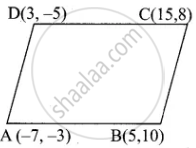Advertisements
Advertisements
प्रश्न
Show that the following points taken in order to form the vertices of a parallelogram
A(−7, −3), B(5, 10), C(15, 8) and D(3, −5)
उत्तर

AB = `sqrt((5 + 7)^2 + (10 + 3)^2`
= `sqrt((12)^2 + (13)^2`
= `sqrt(144 + 169)`
= `sqrt(313)`
BC = `sqrt((15 - 5)^2 + (8 - 10)^2`
= `sqrt(10^2 + (-2)^2`
= `sqrt(100 + 4)`
= `sqrt(104)`
CD = `sqrt((3 - 15)^2 + (-5 - 8)^2`
= `sqrt((-12)^2 + (- 13)^2`
= `sqrt(144 + 169)`
= `sqrt(313)`
AD = `sqrt((3 + 7)^2 + (-5 + 3)^2`
= `sqrt((10)^2 + (-2)^2`
= `sqrt(100 + 4)`
= `sqrt(104)`
AB = CD = `sqrt(313)` and BC = AD = `sqrt(104)` ...(Opposite sides are equal)
∴ ABCD is a parallelogram.
APPEARS IN
संबंधित प्रश्न
If the co-ordinate of A is x and that of B is y, find d(A, B).
x = 6, y = - 2
If the co-ordinate of A is x and that of B is y, find d(A, B).
x = - 3, y = 7
Find d(A, B), if co-ordinates of A and B are -2 and 5 respectively.
On a number line, co-ordinates of P, Q, R are 3, -5 and 6 respectively. State with reason whether the following statement is true or false.
d(P, Q) - d(P, R) = d(Q, R)
Co-ordinates of the pair of a point is given below. Hence find the distance between the pair.
3, 6
Co-ordinates of the pair of points are given below. Hence find the distance between the pair.
- 4, 5
Co-ordinates of the pair of points are given below. Hence find the distance between the pair.
x + 3, x - 3
Find the distance between the following pair of points
(1, 2) and (4, 3)
Verify that the following points taken in order to form the vertices of a rhombus
A(1, 1), B(2, 1), C(2, 2) and D(1, 2)
Show that the point (11, 2) is the centre of the circle passing through the points (1, 2), (3, −4) and (5, −6)
